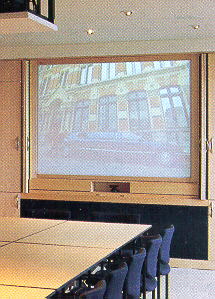How to keep rich dark colors in video images
Ceiling-mounted video projector-->
Note how much light is falling
Forget all
those promotional glossy photos in video projector ads that show a well-balanced
color image on a front projection screen...
and with the room lights full on!
In actual fact, when you try it in your classrooms, the image will probably look more like this.
on the wall around the screen--->
even on the floor and ceiling

Note that the room light is "washing" the dark colors out of the picture. If you look closely, you'll
see a black limo parked in front of the building. Compare the black of the limo with the black speaker cloth below
the screen. No comparison!
Simply put, this is because the screen is white, and in order for the white to look black, there can only be a
limited amount of ambient light reflected off the white screen.
Brighter projectors can increase the contrast and improve the picture, but white still has to be in relative
darkness to look black!
So... even as video projectors improve in brightness, you will still want to
be able to dim the amount of light falling on the front screen... or use a rear screen where the translucent screen is nearly
black, and the image is then reversed L to R and projected thru the screen at the viewers.
Experience shows that turning off the ceiling lights immediately in front
of the white screen, then dimming the fixtures over the viewers down to about 1% of their full brightness (usually
50fc on horizontal surfaces, for full on) gives good results.
Fluorescent dimming ballasts that will dim reliably down to 1%, without having some of the lamps flicker, are readily
available commercially and can be controlled with the simple "lighting scene controller" described on
another page.
A manufacturer who has been very responsible in dealing with any problems I have had is Lutron. Their webpage for 1% fluorescent dimming ballasts is at www.lutron.com/hilume/
Have a classroom design question, or a good idea? E-mail:

